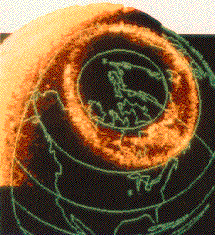Dynamics Explorer
Dynamics Explorer was a NASA mission, launched on August 3, 1981 and terminated on February 28, 1991.[1] It consisted of two unmanned satellites, DE-1 and DE-2, whose purpose was to investigate the interactions between plasmas in the magnetosphere and those in the ionosphere.[2] The two satellites were launched together into polar coplanar orbits, which allowed them to simultaneously observe the upper and lower parts of the atmosphere.
| Mission type | Magnetospheric research |
|---|---|
| Operator | NASA |
| COSPAR ID | 1981-070A |
| SATCAT no. | 12624 |
| Spacecraft properties | |
| Manufacturer | RCA Astro |
| Launch mass | 424 kilograms (935 lb) |
| Power | 68 W |
| Start of mission | |
| Launch date | August 03, 1981, 09:56:00 UTC |
| Rocket | Delta 3913 642/D155 |
| Launch site | Vandenberg SLC-2W |
| Orbital parameters | |
| Reference system | Geocentric |
| Regime | HEO |
| Semi-major axis | 18,238.0 kilometers (11,332.6 mi) |
| Eccentricity | 0.6238922 |
| Perigee altitude | 488.6 kilometers (303.6 mi) |
| Apogee altitude | 23,246.3 kilometers (14,444.6 mi) |
| Inclination | 89.959° |
| Period | 408.5 minutes |
| Epoch | 27 June 2016 |
| Revolution no. | 59680 |
| Mission type | Magnetospheric research |
|---|---|
| Operator | NASA |
| COSPAR ID | 1981-070B |
| SATCAT no. | 12625 |
| Spacecraft properties | |
| Manufacturer | RCA Astro |
| Launch mass | 420 kilograms (926 lb) |
| Power | 115 W |
| Start of mission | |
| Launch date | August 03, 1981, 09:56:00 UTC |
| Rocket | Delta 3913 642/D155 |
| Launch site | Vandenberg SLC-2W |
| End of mission | |
| Decay date | February 19, 1983 |
| Orbital parameters | |
| Reference system | Geocentric |
| Regime | LEO |
| Eccentricity | 0.03 |
| Perigee altitude | 309 kilometers (192 mi) |
| Apogee altitude | 1,012 kilometers (629 mi) |
| Inclination | 89.99° |
| Period | 98 minutes |
| Epoch | 03 August 1981 |
| Revolution no. | 8593 |
Design
Both spacecraft had a polygonal shape, and were approximately 137 cm in diameter and 115 cm high. Each also had a 200-cm radio antenna and two 6-meter booms which were needed to distance some of the equipment from the main body of the spacecraft. They were stacked on top of each other and launched aboard a Delta 3000 booster rocket. Upon reaching orbit, the two spacecraft departed from the booster and entered separate orbits. Dynamics Explorer 1 was placed into a high altitude elliptical orbit, while DE-2 was put into a lower orbit that was also more circular.
Dynamics Explorer 1 Instrumentation
Dynamics Explorer 1 carried the following instruments[3]:
- Plasma Wave Instrument (PWI), which measured auroral kilometric radiation, auroral hiss, Z-mode radiation, and narrow band electromagnetic emissions.
- The Spin-scan Auroral Imager (SAI)
- The Retarding Ion Mass Spectrometer (RIMS)
- Energetic Ion Composition Spectrometer (EICS)
- High Altitude Plasma Instrument (HAPI)
- Magnetic Field Observations Triaxial Fluxgate Magnetometer (MAG-A)
In addition, there were two Earth-based investigations, Auroral Physics Theory and Controlled and Naturally Occurring Wave Particle Interactions Theory. The later involved broadcasting very-low-frequency/low-frequency (0.5-200 kHz) signals from a transmitter located at Siple, Antarctica, which were received by the PWI instrument on Dynamics Explorer 1.
Dynamics Explorer 2 Instrumentation
The Dynamics Explorer 2 carried the following instruments for data collection:
- A Retarding Potential Analyzer, which measured the ion flux along the velocity vector of the spacecraft. This data was then used to determine the ion temperature and drift velocity in the spacecraft's area.[4]
- An Ion drift meter, which measured the ambient ion drift.
- A Magnetometer
- A Vector Electric Field Instrument
 An aurora as seen by one of the Dynamics Explorers
An aurora as seen by one of the Dynamics Explorers - A Neutral Atmosphere Composition Spectrometer
- A Wind and Temperature Spectrometer (WATS), which measured the zonal and vertical components of the neutral winds, as well as the kinetic temperature.[5] (The zonal wind component is the component in the direction of lines of latitude - i.e., east-west.) The WATS instrument on DE-2 is one of the few satellite instruments which has measured thermosphere vertical wind speeds, with the Neutral Atmosphere Temperature Instrument (NATE)[6] on Atmospheric Explorer C (AE-C) being one other.
- A Fabry–Pérot interferometer (FPI), which measured the meridional component of the neutral winds.[5] (The meridional wind component is the component in the direction of lines of longitude - i.e., north-south.)
- A Low-Altitude Plasma Instrument
- A Langmuir probe
Mission Results
As a result of a malfunction in the Delta 3000 booster rocket in which its main engine shut off slightly early, DE-2 was placed into a slightly lower orbit than was anticipated. This was not a serious problem, however, and the spacecraft had lasted its expected lifespan when it re-entered the Earth's atmosphere on February 19, 1983. DE-1, being in a higher orbit, continued to collect data until 1991, when the mission was officially terminated.
References
- DE (Dynamics Explorer)
- NSSDC Master Catalog
- "National Space Science Data Center: Experiments on Dynamics Explorer 1". NASA/NSSDC.
- Dynamics Explorer 2 Archived 2007-03-15 at the Wayback Machine
- Spencer, N. W., Wharton, L. E., Carignan, G. R. and Maurer, J. C. (1982), Thermosphere zonal winds, vertical motions and temperature as measured from Dynamics Explorer. Geophys. Res. Lett., 9: 953–956. doi:10.1029/GL009i009p00953.
- Spencer, N. W., Theis, R. F., Wharton, L. E. and Carignan, G. R. (1976), Local vertical motions and kinetic temperature from AE-C as evidence for aurora-induced gravity waves. Geophys. Res. Lett., 3: 313–316. doi:10.1029/GL003i006p00313.
.png)